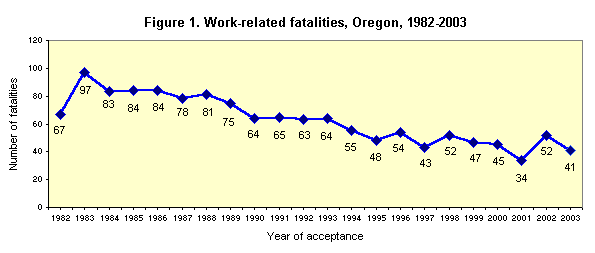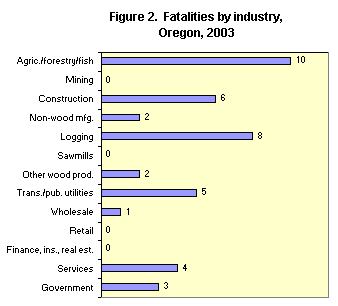 |
Work-Related Compensable
by Elizabeth Priddy |
The number of work-related compensable fatalities in Oregon decreased from 52 in 2002 to 41 in 2003 (see Figure 1). Work-related fatalities are those fatalities that were accepted as compensable by an insurer during 2003 and for which the Department of Consumer & Business Services received notification by January 31, 2004.

Of the 41 work-related fatalities in 2003, 38 were men and three were women, compared to 47 men and five women in 2002. The median age of these workers was 41 years. The youngest worker killed was a 16-year-old camp counselor who had tried to fire a cannon that malfunctioned during a flag ceremony. After the ceremony, when he added additional powder and tried to ignite the charge, the cannon exploded. The oldest worker killed was a 75-year-old logger/cat skinner who was operating a bulldozer (with rear grapples) while attempting to repair an old skid road for a logging company. He was using the blade to clear trees and grade a new road on a steep hill. The tracks of the vehicle struck rock and when he attempted to turn around with the grapples and blade raised to allow clearance, the machine became unbalanced, rolled over an embankment and down a 600-foot slope. The worker was tossed from the rolling machine.
 The
agriculture, forestry, and fishing industry group accounted for the highest
number of fatalities with 10, followed by logging with eight fatalities
(see Figure 2). The occupation with the most compensable fatalities was
service occupations with 10 fatalities. Nine of these were firefighters.
The
agriculture, forestry, and fishing industry group accounted for the highest
number of fatalities with 10, followed by logging with eight fatalities
(see Figure 2). The occupation with the most compensable fatalities was
service occupations with 10 fatalities. Nine of these were firefighters.
Transportation accidents resulted in the greatest number of compensable fatalities with a total of 22 deaths. These accidents included collisions, overturned vehicles, and fatalities in which workers were struck or pinned by vehicles. This number also includes six workers killed in aircraft accidents and one worker killed as a pedestrian. Seven workers were killed by being struck by an object. One fatality resulted from workplace violence in 2003.
In 2003, Malheur County had the most fatalities with eight of the 41. Lane County accounted for five fatalities, and five workers were killed outside Oregon. Sixteen of the workers had been employed for a year or less at the time of their injury, including five workers killed during the first month of employment. These fatalities indicate the need for training and supervision of all new employees.
DCBS Public Home Page | IMD
Home Page|
If you have questions about the information contained in this document, please contact by e-mail or phone: Elizabeth Priddy, (503) 947-7051, Research Analyst, Research & Analysis Section, Information Management Division
In compliance with the Americans with Disabilities Act (ADA), all IMD publications are available in alternative formats by calling (503) 378-4100 (V/TTY). The information in IMD publications is in the public domain and may be reprinted without permission.